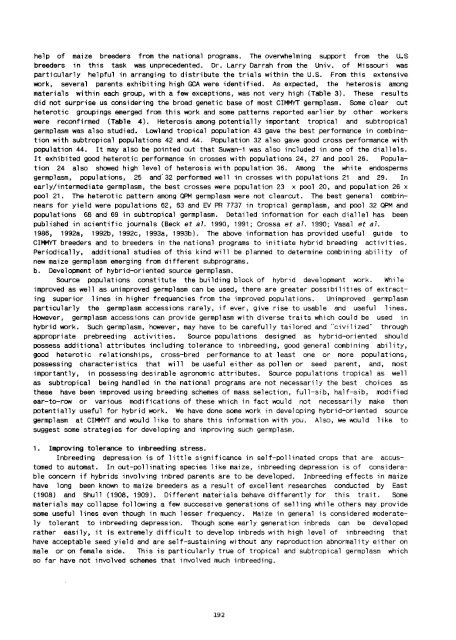Proceedings of the Fifth Asian Regional Maize Workshop - Search ...
Proceedings of the Fifth Asian Regional Maize Workshop - Search ...
Proceedings of the Fifth Asian Regional Maize Workshop - Search ...
You also want an ePaper? Increase the reach of your titles
YUMPU automatically turns print PDFs into web optimized ePapers that Google loves.
help <strong>of</strong> maize breeders from <strong>the</strong> national programs. The overwhelming support from <strong>the</strong> u.s<br />
breeders in this task was unprecedented. Dr. Larry Darrah from <strong>the</strong> Univ. <strong>of</strong> Missouri was<br />
particularly helpful in arranging to distribute <strong>the</strong> trials within <strong>the</strong> u.s. From this extensive<br />
work, several parents exhibiting high GCA were identified. As expected, <strong>the</strong> heterosis among<br />
materials within each group, with a few exceptions, was not very high (Table 3). These results<br />
did not surprise us considering <strong>the</strong> broad genetic base <strong>of</strong> most CIMMYT germp1asm. Some clear cut<br />
heterotic groupings emerged from this work and some patterns reported earlier by o<strong>the</strong>r workers<br />
were reconfirmed (Table 4). Heterosis among potentially important tropical and subtropical<br />
germplasm was also studied. Lowland tropical population 43 gave <strong>the</strong> best performance in combination<br />
with subtropical populations 42 and 44. Population 32 also gave good cross performance with<br />
population 44. It may also be pointed out that Su~an-1 was also included in one <strong>of</strong> <strong>the</strong> dia11e1s.<br />
It exhibited good heterotic performance in crosses with populations 24, 27 and pool 26. Population<br />
24 also showed high level <strong>of</strong> heterosis with population 36. Among <strong>the</strong> white endosperms<br />
germp1asm, populations, 25 and'32 performed well in crosses with populations 21 and 29. In<br />
early/intermediate germp1asm, <strong>the</strong> best crosses were population 23 x pool 20, and population 26 x<br />
pool 21. The heterotic pattern among QPM germp1asm were not c1earcut. The best general combinnears<br />
for yield were populations 62, 63 and EV PR 7737 in tropical germp1asm, and pool 32 QPM and<br />
populations 68 and 69 in subtropical germp1asm. Detailed information for each dia11el has been<br />
published in scientific journals (Beck et a7. 1990, 1991; Crossa et a7. 1990; Vasal et a7.<br />
1986, 1992a, 1992b, 1992c, 1993a, 1993b). The above information has provided useful guide to<br />
CIMMYT breeders and to breeders in <strong>the</strong> national programs to initiate hybrid breeding activities.<br />
Periodically, additional studies <strong>of</strong> this kind will be planned to determine combining ability <strong>of</strong><br />
new maize germplasm emerging from different subprograms.<br />
b. Development <strong>of</strong> hybrid-oriented source germp1asm.<br />
Source populations constitute <strong>the</strong> building block <strong>of</strong> hybrid development work. While<br />
improved as well as unimproved germp1asm can be used, <strong>the</strong>re are greater possibilities <strong>of</strong> extracting<br />
superior lines in higher frequencies from <strong>the</strong> improved populations. Unimproved germp1asm<br />
particularly <strong>the</strong> germp1asm accessions rarely, if ever, give rise to usable and useful lines.<br />
However, germp1asm accessions can provide germp1asm with diverse traits which could be used in<br />
hybrid work. Such germp1asm, however, may have to be carefully tailored and "civilized" through<br />
appropriate prebreeding activities. Source populations designed as hybrid-oriented should<br />
possess additional attributes including tolerance to inbreeding, good general combining ability,<br />
good heterotic relationships, cross-bred performance to at least one or more populations,<br />
possessing characteristics that will be useful ei<strong>the</strong>r as pollen or seed parent, and, most<br />
importantly, in possessing desirable agronomic attributes. Source populations tropical as well<br />
as subtropical being handled in <strong>the</strong> national programs are not necessarily <strong>the</strong> best choices as<br />
<strong>the</strong>se have been improved using breeding schemes <strong>of</strong> mass selection, full-sib, half-sib, modified<br />
ear-to-row or various modifications <strong>of</strong> <strong>the</strong>se which in fact would not necessarily make <strong>the</strong>n<br />
potentially useful for hybrid work. We have done some work in developir.g hybrid-oriented source<br />
germp1asm at CIMMYT and would like to share this information with you. Also, we would like to<br />
suggest some strategies for developing and improving such germp1asm.<br />
1. Improving tolerance to inbreeding stress.<br />
Inbreeding depression is <strong>of</strong> little significance in self-pollinated crops that are accustomed<br />
to automat. In out-pollinating species like maize, inbreeding depression is <strong>of</strong> considerable<br />
concern if hybrids involving inbred parents are to be developed. Inbreeding effects in maize<br />
have long been known to maize breeders as a result <strong>of</strong> excellent researches conducted by East<br />
(1908) and Shull (1908, 1909). Different materials behave differently for this trait. Some<br />
materials may collapse following a few successive generations <strong>of</strong> selling while o<strong>the</strong>rs may provide<br />
some useful lines even though in much lesser frequency. <strong>Maize</strong> in general is considered moderately<br />
tolerant to inbreeding depression. Though some early generation inbreds can be developed<br />
ra<strong>the</strong>r easily, it is extremely difficult to develop inbreds with high level <strong>of</strong> inbreeding that<br />
have acceptable seed yield and are self-sustaining without any reproduction abnormality ei<strong>the</strong>r on<br />
male or on female side. This is particularly true <strong>of</strong> tropical and subtropical germplasm which<br />
so far have not involved schemes that involved much inbreeding.<br />
192

















